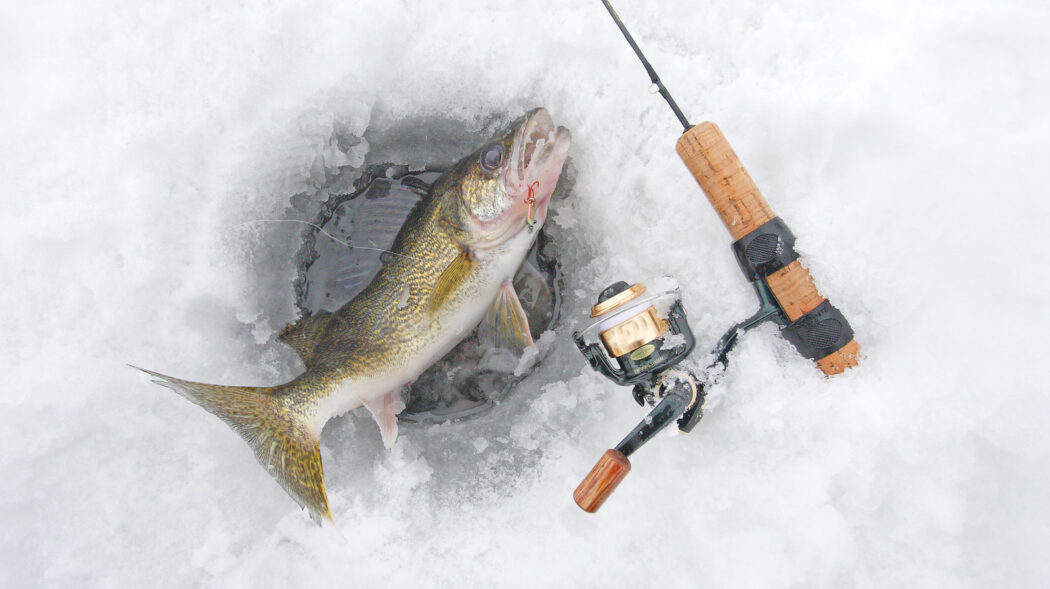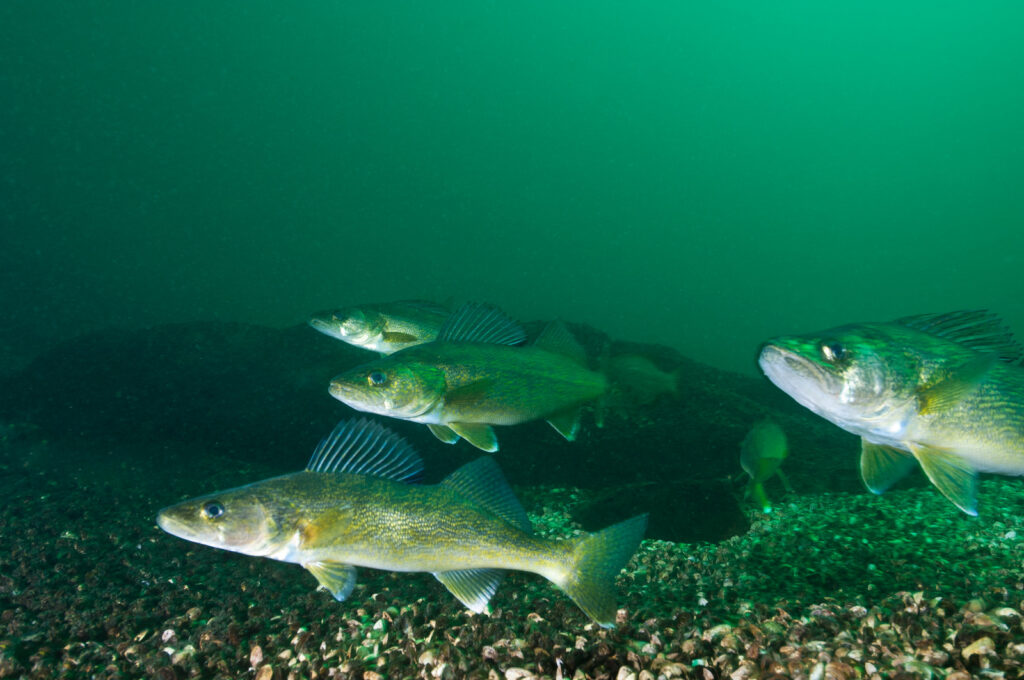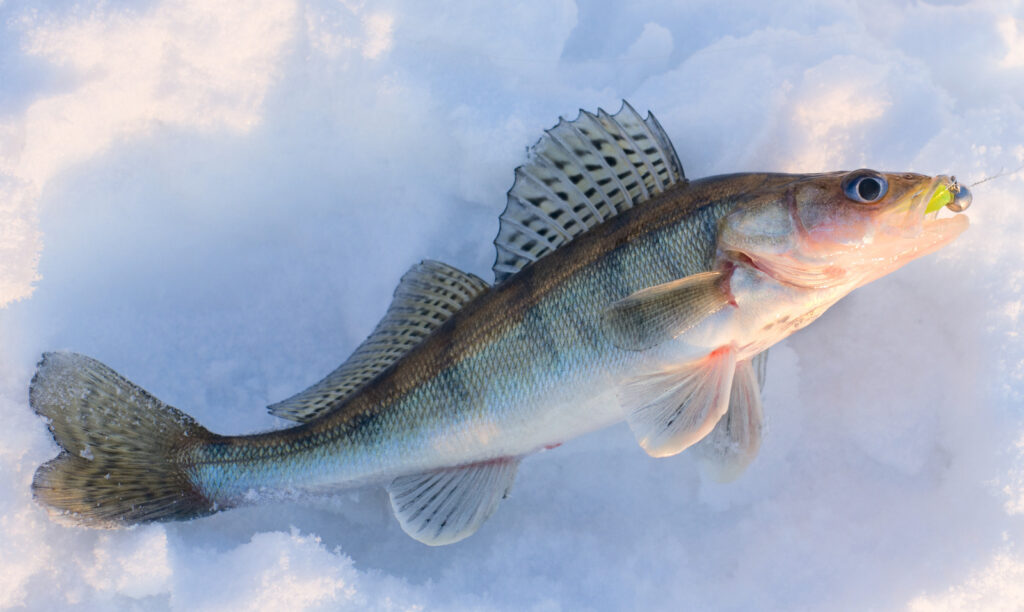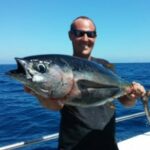Ice Fishing For Walleye: Best Jigs Lures, Rods & Line

The lake may be frozen but the Walleye are still biting. If you can brave the cold, catching walleye through the ice is a fun break from the norm. Here are some fishing tips to help you succeed ice fishing for walleye.
Where To Find Walleye For Ice Fishing
Walleye have a reputation for being mobile. Tag and recapture studies have found Walleye over 200 miles away but a lot of biologists think that this isn’t the case in winter.
Walleye spawn in spring, but they start traveling to their spawning grounds in autumn and the fall. This way they have all winter to rest nearby before the stress of pregnancy and egg-laying begins.
Spawning areas of walleye are:
- In shallow water, usually 1 to 6 feet deep, but can be up to 20 feet in depth.
- A bottom with rocks, gravel, or similar bed.
- Near gentle current to clean and aerate the eggs.
Walleye Like To Hunker Down
The grouping of walleye near spawning grounds is why I get so much action in winter. Like people, walleye don’t like to move around much in the cold which makes walleye ice fishing a lot of fun. Once you find them, simply set up your ice fishing shelter, put on your ice fishing bib, pull up your cozy fishing chair and enjoy a great day on the ice.
When walleye do move, it is mostly vertical from deep to shallow, and back to deep. Any structure is where they’ll be holding. Sand bars, reefs, and points of land that jut out are classic holding areas.
Walleye Don’t Like Sunlight, Hang Out Near Food Sources

Two good clues that help find and catch walleye in the ice are low light and food supply. If I can pair a food source with structure and a nearby spawn area, I know I’ve found a honey-hole and I’ll start drilling holes. This is where to start cutting through the ice.
The main diet of walleye is smaller fish. They love perch, smelt, shiners, and minnows, but anything small enough including leeches and nightcrawlers they’ll eat, too. When the food goes shallow, the walleye go shallow. And the same thing when it goes deep.
But the one thing that takes the walleye bite from 0 to 60 is light. Walleye are very sensitive to sunlight, and I have found they are more active at sunset and sunrise as they prefer low light. Both of these times of day are as cold as they get so make sure you have a quality ice fishing heater.
Digging holes at different depths capitalizes on walleye movement. Especially as the light changes, many holes in the ice let me catch them as they feed high or low.
Best Ice Fishing Lures To Catch Walleye

A good pro-tip for catching walleye in ice fishing season is don’t overcomplicate things. Ice fishing usually requires a lot of gear like picking the best ice fishing pick. When it comes to lures, no matter where I’m at in North America, there are just four lures needed to catch walleye:
- Rapala Jigging Rap.
- Spoons.
- Lipless crankbait.
- Jig.
Rapala Jigging Rap
This long and slender lure can mimic a shiner or other small baitfish that walleye love. It has treble hooks and another hook on the nose for better hooksets. Its appeal comes from the bills on the back. These give it a horizontal swimming action that attracts bites.
Spoons
Spoons are one of the oldest styles of lures still used for walleye fishing. Its design is simple yet deadly effective.
Just a hook on a flat chunk of metal, spoons are a staple of winter fishing because they flat-out work. Walleye love an easy meal, and spoons look just like a dying minnow. This is because of the slow flutter action as it falls and the light it throws off from its shiny surface.
Lipless Crankbait
A Lipless crankbait is the most realistic-looking lure on the list for catching walleye through the ice. I like to use the ones made by Live Target in golden shiner or shad paint jobs.
Lipless cranks fall horizontally, not head down. This mimics a small fish using its swim bladder to fall through the water column. The lipless cranks with rattles inside work great in wintertime, too. That extra noise stimulates cold walleye into chasing after a quick meal.
The Good Old Fashioned Jig
I’m talking about a single hook with a head on top. I like a single willow blade on it for extra flash and vibration, too. This can be jigged like the others, or used as an excellent deadstick bait.
A good tip while ice fishing for walleye is to deadstick a jig with a live minnow in one hole while busy with another. Many times I’ll catch a flurry of fish and then the bites will suddenly stop. Right when this happens I’ll look over and see my deadstick bowed from a walleye on the line. This technique is a great one-two combination to keep the action going.
Lure Color and Cadence
Most fish are pretty sluggish in wintertime and walleye are no different. A little extra pizzaz is often needed to motivate them to bite. If you’re not landing walleye out on the ice, the best suggestion is bright-colored lures and a change in cadence.
It’s been proven that walleye see the colors red, orange, and yellow the best. They also see greens, so chartreuse painted lures will work well, too.
By cadence, I’m talking about the rhythm of jigging. The four best lures for walleye fishing listed above are all used with upward and downward flicks of the rod. Sometimes a more aggressive cadence will be too much for walleye to resist.
Best Walleye Ice Fishing Rod, Reel, and Line

Digging a hole in the ice and dropping a line down is obviously different than how fishing for walleye is done most of the year. It’s a whole different game that requires completely different gear. Below is what I recommend.
Rods: Jigging and Deadstick
I mentioned the jigging and deadstick combo earlier. The jigging rod stays in hand while the other sits in a hole, alone. This means a difference between the two in bite detection and play.
I like my jigging rod 30″ to 36″ long, (or short, more precisely). The main thing is its sensitivity. Winter walleye aren’t biting very powerfully, so I need to feel those soft hits. A fast action tip gives a good hookset when they do.
The dead stick is different. Since I’m not holding it I’m not worried about sensitivity. But I want a slower action with a bend further down the rod. This lets me see a fish is on the line and gives the walleye less resistance as it thinks about swallowing the lure or not.
Inline Reels
Most people ice fishing for walleye have moved to inline reels, and I’m one of them. It’s all about line management. The line comes off inline reels straight similar to baitcasters, not in a coil like spinning reels that can spook fish.
Besides stopping line twist, the larger spool means less memory than a spinning rig, too. My favorite thing about inline reels, though, is the control I have. The trigger mechanism drops my lure more evenly and lets me pinpoint just where I want it to stop.
Fluorocarbon Line
Water can be gin-clear in winter. The cold stops algae from blooming and less sediment get blown around. Fluorocarbon line is almost invisible in water, which is absolutely necessary this time of year. A 6 to 10-pound test should cover most scenarios.
The line can become frozen and stiff, too. A uni-filament line like the Berkley NanoFil won’t absorb water, which solves that problem. It also has no stretch, increasing the whole rig’s sensitivity.
In Summary
Ice fishing for walleye has its challenges but is a fun change of pace. Walleye are a bit finicky this time of year so take advantage of their winter patterns. Identifying walleye spawn staging area, food source and feeding habits will make this a productive part of the fishing season and help you join the ranks of bonafide walleye anglers.
If you’re interested in learning how to ice fish for crappie, check out our useful guide.
As an Amazon Associate, Fishermen's Angle earns from qualifying purchases. We get commissions for purchases made through links in this post.
